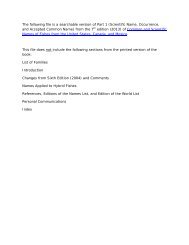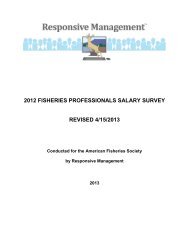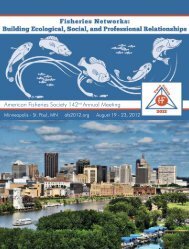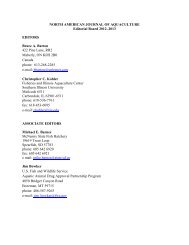Conservation Status of Crayfish Species Paddlefish Conservation ...
Conservation Status of Crayfish Species Paddlefish Conservation ...
Conservation Status of Crayfish Species Paddlefish Conservation ...
You also want an ePaper? Increase the reach of your titles
YUMPU automatically turns print PDFs into web optimized ePapers that Google loves.
mum length limit increases and that regulation<br />
change was subsequently enacted.<br />
The proposal to shorten the season and<br />
end it on 31 March was met with comments<br />
from fishers that the commission should not<br />
confuse academic research with reality and<br />
that shortening the season and raising the<br />
length limit at the same time would hurt their<br />
businesses too much. The TWRC agreed<br />
with the latter assertion and amended the<br />
proclamation to end the season on 15 April.<br />
TWRA staff biologists were confident that<br />
the TWRC would approve the 31 March<br />
closure; thus, they did not propose a mon<strong>of</strong>ilament<br />
ban. Upon learning that the season<br />
would end two weeks later than proposed,<br />
an attempt was made to convince the commissioners<br />
that a later closure date should be<br />
accompanied by a mon<strong>of</strong>ilament ban, but<br />
that request was denied.<br />
The regulation to ban blocking <strong>of</strong> carcasses<br />
was opposed, as expected, by the fishing<br />
industry and several fishers spoke forcefully to<br />
the issue. Several TWRA staff countered that<br />
sport anglers are not allowed to process their<br />
catch onboard and commercial fishers should<br />
not be treated any differently. The TWRC<br />
was unconvinced by that argument and voted<br />
to allow fishers to block their catch. The final<br />
recommendation (limited entry) met with<br />
no opposition and the TWRC voted to limit<br />
the number <strong>of</strong> roe fish permits that would be<br />
issued during future seasons to 115% <strong>of</strong> permit<br />
sales during the 2005–2006 license year.<br />
In summary, the TWRC enacted two regulations<br />
(establish a refuge and limit the number<br />
<strong>of</strong> roe fish permits) that would help keep<br />
fishing pressure from rising higher than the<br />
Kentucky Lake stock was currently experiencing.<br />
However, those two regulations would do<br />
little to reverse the trend <strong>of</strong> declining size- and<br />
age-structure <strong>of</strong> the population. The new minimum<br />
length limit regulation that passed was<br />
intended to increase the average age and size<br />
<strong>of</strong> fish in the population, and reduce the likelihood<br />
<strong>of</strong> growth and recruitment overfishing.<br />
The higher minimum length limits also satisfied<br />
the desire to allow at least some female<br />
paddlefish to spawn at least once before they<br />
were vulnerable to harvest, a common theme<br />
in marine fisheries management plans (Myers<br />
and Mertz 1998). However, the efficacy <strong>of</strong> the<br />
higher minimum length limit regulation was<br />
in question because (1) already high bycatch<br />
rates would climb under the higher length<br />
limit, and (2) shortening the season by only<br />
eight days (and not banning mon<strong>of</strong>ilament<br />
netting) might not reduce bycatch mortality<br />
to acceptably low rates.<br />
With these new regulations in place (refuge<br />
area, cap on permits, higher minimum<br />
length limit, slightly shorter season), the<br />
2005–2006 commercial season commenced.<br />
When fishery harvest data were tallied after<br />
the season ended in April 2006, it was clear<br />
that the 2005–2006 season was exceptional.<br />
Rainfall and river flows were modest, fishers<br />
had ample opportunity to deploy their<br />
gear, and the reported statewide harvest <strong>of</strong><br />
egg-bearing paddlefish (n = 7,277 fish) and<br />
the egg harvest (12,827 kg) were the highest<br />
ever recorded by TWRA. Coupled with<br />
an increase in prices that fishers were getting<br />
for paddlefish eggs (approaching US$200/<br />
kg), such high harvests prompted TWRA to<br />
redouble their efforts to shorten the season to<br />
their original target <strong>of</strong> 31 March.<br />
Another facilitated meeting was held in<br />
June 2006 to present the previous season’s<br />
harvest data and discuss possible regulation<br />
changes; in particular, shortening the season<br />
from 15 April to 31 March. As before, the<br />
fishing industry chose seven representatives<br />
to represent its interests. Fishers were adamant<br />
in not wanting to shorten the season<br />
any further for the same reasons voiced at earlier<br />
meetings. The fishers themselves put forth<br />
several proposals, most notably to cease fishing<br />
when a certain temperature was reached<br />
and to ban the use <strong>of</strong> mon<strong>of</strong>ilament netting<br />
after 31 March. These two recommendations<br />
were an acknowledgment by fishers that<br />
bycatch mortality is problematic when waters<br />
are warm and that mon<strong>of</strong>ilament netting is<br />
more injurious than multifilament netting.<br />
These recommendations were proposed to<br />
Large, mature female paddlefish, like this<br />
one being held by Janice kerns, represent a<br />
small percentage <strong>of</strong> all paddlefish caught in<br />
commercial gillnets. Photo by Phil bettoli.<br />
forestall what the fishers probably suspected<br />
was inevitable: shortening the season yet<br />
again to further reduce harvest.<br />
The TWRA representatives responded<br />
by stating (1) closing the season when a certain<br />
temperature is reached might have some<br />
merit, and (2) the possibility <strong>of</strong> a mon<strong>of</strong>ilament<br />
ban was taken <strong>of</strong>f the table last year and<br />
should not be brought up again at this time.<br />
When asked to rank the various management<br />
options discussed at this meeting, the<br />
fishers ranked “No change” (which was not<br />
an option) as number 1, followed by ending<br />
the season when a specific temperature was<br />
reached, and closing the fishery each year on 7<br />
April (8 days sooner). After a heated debate, a<br />
consensus was reached among the fishers that<br />
closing the season on 7 April was acceptable.<br />
That consensus was reached after one fisher<br />
noted that the TWRC would view them very<br />
unfavorably if they failed to act responsibly<br />
and agree to do something to reduce what<br />
many agreed (either privately or publicly) was<br />
an unsustainable harvest.<br />
At the regularly scheduled TWRC<br />
monthly meeting in September 2006, the<br />
commissioners saw one more PowerPoint<br />
presentation. The high harvest numbers from<br />
the previous season were discussed and it was<br />
recommended (again) that the paddlefish<br />
season should end on 31 March each year.<br />
It was also proposed that the number <strong>of</strong> roe<br />
fish permits should be limited to 80 each year<br />
(this was 115% <strong>of</strong> 2005–2006 permit sales).<br />
The 16+ commercial fishers in the audience<br />
argued many points, in particular that they<br />
had already given up enough and that they<br />
Fisheries • vol 32 no 8 • august 2007 • www.fisheries.org 395







